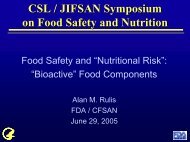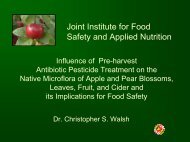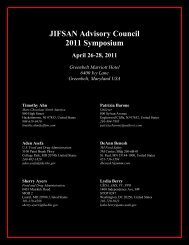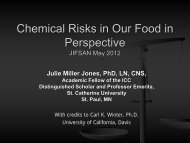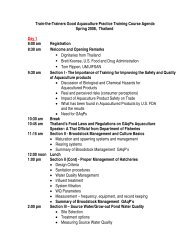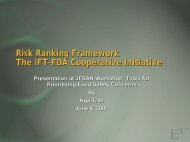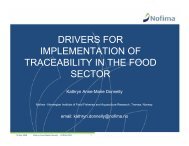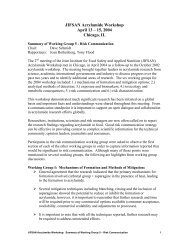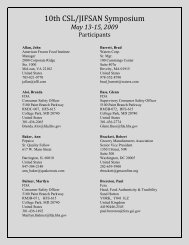Acrylamide in Foods: Toxicology, Epidemiology and ... - jifsan
Acrylamide in Foods: Toxicology, Epidemiology and ... - jifsan
Acrylamide in Foods: Toxicology, Epidemiology and ... - jifsan
You also want an ePaper? Increase the reach of your titles
YUMPU automatically turns print PDFs into web optimized ePapers that Google loves.
Hemoglob<strong>in</strong> Adducts <strong>in</strong> Humans• Workers with neurotoxic symptoms• Ch<strong>in</strong>ese <strong>and</strong> Korean workers, polyacrylamide manufacture• Swedish workers, tunnel construction• > 500 to 18,000 picomoles/g glob<strong>in</strong>• Controls with no occupational exposure• Smok<strong>in</strong>g• Non-smok<strong>in</strong>g• Laboratory workers• Polyacrylamide gels116 picomoles/g glob<strong>in</strong>31 picomoles/g glob<strong>in</strong>54 picomoles/g glob<strong>in</strong>
Average <strong>Acrylamide</strong> per Serv<strong>in</strong>g*<strong>Acrylamide</strong>,Approximate<strong>Acrylamide</strong>,FoodPPB or ug perkg foodServ<strong>in</strong>g Size**ug per serv<strong>in</strong>gBreakfast Cereal1332 ounces7.3Brewed Coffee81 cup2.0Cookies2221 ounce6.6French Fries, (RF)3222 ½ ounces22.5French Fries, (OB)6982 ½ ounces48.8Potato Chips5481 ounce16.4Soft Bread441 slice2.2Toast2131 slice9.8*FDA exploratory data on acrylamide <strong>in</strong> foods through Feb 2003**Nutrition Label Serv<strong>in</strong>g Sizes (21 CFR 101.12, Table 2)
Formation of <strong>Acrylamide</strong> <strong>in</strong> Food• Side reaction of brown<strong>in</strong>g reactions <strong>in</strong> food• Non-enzymatic brown<strong>in</strong>g• Maillard reaction• Reduc<strong>in</strong>g sugar (glucose, fructose) + am<strong>in</strong>o acids• <strong>Acrylamide</strong> formation• Reduc<strong>in</strong>g sugar + asparag<strong>in</strong>e• Temperature > 100 deg C• Low moisture
FAO/WHO ConsultationHealth Implications of <strong>Acrylamide</strong>• June 2002• Confirmed presence of acrylamide <strong>in</strong> foods• Estimated average <strong>in</strong>take, 0.3 to 0.8 ug/kg bw/d• No neurotoxic effects expected at these levels• Carc<strong>in</strong>ogenic potency of acrylamide <strong>in</strong> animals• Similar to other carc<strong>in</strong>ogens <strong>in</strong> human diet• Likely overall human <strong>in</strong>take is higher• No evidence on carc<strong>in</strong>ogenesis <strong>in</strong> humans• Major concern based on <strong>in</strong>duction of cancer <strong>and</strong>heritable mutations <strong>in</strong> animals
FDA Estimate of Mean <strong>Acrylamide</strong> IntakeCFSII 1994-96, 1998; Ages 2 <strong>and</strong> OlderFoodMeanacrylamide<strong>in</strong>take(ug/kg bw/d)Percent oftotal<strong>in</strong>takeCumulativepercentFrench Fries (RF)0.0561415French Fries (OB)0.0491328Breakfast Cereal0.0441154Potato Chips0.0411052Cookies0.0401062Brewed Coffee0.027770Toast0.023677Soft Bread0.020582Other <strong>Foods</strong> Tested0.07018100Total0.37100100
Other Tested <strong>Foods</strong> Contribut<strong>in</strong>g toFDA’s Estimate of <strong>Acrylamide</strong> IntakeTested <strong>Foods</strong> Provid<strong>in</strong>g the Rema<strong>in</strong><strong>in</strong>g18% of Estimated Mean <strong>Acrylamide</strong>IntakeCorn snacksCrackersPretzelsPopcornBaked beansBreaded chickenPeanut butterSoup mixCocoaCrisp bread,matzoInstant coffeeBagelsChocolateTortillaBreaded fishDoughnutsAlmondsNuts & seedsTaroSoy prote<strong>in</strong>Pork r<strong>in</strong>dsMalted dr<strong>in</strong>ks
FDA Prelim<strong>in</strong>ary ExposureAssessment Implications• Estimated average US exposure• Similar to <strong>in</strong>ternational estimates• 1000 x below animal neurotoxic or carc<strong>in</strong>ogen levels• Exposure of small children• 2-3 times greater per kg body weight• Expected based on body size <strong>and</strong> food <strong>in</strong>take
Workers Exposed to AA <strong>in</strong> Three U.S.& One Dutch Chemical Plants• Cohort of 8508 workers potentially exposed toAA at 3 U.S. chemical plants & one plant <strong>in</strong>Netherl<strong>and</strong>s 1925-89 (Coll<strong>in</strong>s et al, 1989)• Data on cohort updated cover<strong>in</strong>g 11 yrs.(Marsh et al., 1999)• “Most def<strong>in</strong>itive study of the humancarc<strong>in</strong>ogenic potential of exposure to AAconducted to date.”
AA Worker Study (cont’d.)• Authors of study found <strong>in</strong>creased SMRs ofrectal, esophageal, pancreatic & kidneycancers for some categories of exposure toAA, but little evidence of exposure-responserelations• 2.26-fold risk (95% CI 1.03 – 4.29) found forpancreatic cancer among workers withcumulative exposure to AA >0.30 mg/m 3 yrs,but no consistent exposure-response relation
Worker AA Study (cont’d.)• Authors noted limitations of study to be a largeproportion of short term workers, low AA exposure,<strong>in</strong>complete smok<strong>in</strong>g data• Low statistical power to detect cancers of bra<strong>in</strong> & CNS,thyroid gl<strong>and</strong>, testis & other male genital organs• Good statistical power to detect respiratory cancers• Authors concluded little evidence for a causal relationbetween exposure to AA <strong>and</strong> mortality from any cancersite
<strong>Epidemiology</strong> Study on Dietary<strong>Acrylamide</strong> <strong>and</strong> Cancer Risk• Case-control study, January, 2003• Men <strong>and</strong> women <strong>in</strong> Stockholm, Sweden• Aged 51 to 77• Found no positive association between dietaryacrylamide <strong>and</strong> <strong>in</strong>cidence of cancer of largebowel, bladder, kidney
<strong>Epidemiology</strong> Study on Dietary<strong>Acrylamide</strong> <strong>and</strong> Cancer Risk• Dietary acrylamide• Food frequency questionnaire• Swedish acrylamide food data• Various fried <strong>and</strong> baked potatoes, crisp breads, soft breads,breakfast cereals, biscuits• Did not <strong>in</strong>clude coffee or toast<strong>in</strong>g of soft breads• Subjects• 538 controls• 591 large bowel cancer• 263 bladder cancer• 133 kidney cancer• Source: Mucci et al., 2003
Study Evaluation• Authors concluded that“<strong>Acrylamide</strong> <strong>in</strong>take through dietary sources may thus beeffectively detoxified with<strong>in</strong> the range of human exposure.”• StrengthsThis was a well-conducted study with strengths that reduced thepossibility of selection bias <strong>and</strong> recall bias, <strong>and</strong> adjusted formajor confound<strong>in</strong>g variables.• LimitationsThe limitations of the study could expla<strong>in</strong> the observed lack ofassociation, even if a true association exists
Limitations of Study• May prevent detection of an association ifthere is a true association• Limited statistical power to detect a small risk if oneexists• Possible uniformity of acrylamide <strong>in</strong>take• Omission of some food sources of acrylamide• Did not adjust for possible residual confound<strong>in</strong>g byadditional nutrients, food components• Did not study possible excess risk of acrylamide<strong>in</strong>take at other cancer sites
Authors’ Recommendations• Determ<strong>in</strong>e cook<strong>in</strong>g methods that avoidacrylamide formation dur<strong>in</strong>g food preparation• Validation of food questionnaires foracrylamide <strong>in</strong>take should be a high priority• Additional epidemiological evidence is needed• Other cancer sites• Neurological <strong>and</strong> other disorders
<strong>Epidemiology</strong> Study on Fried/BakedPotatoes <strong>and</strong> Cancer Risk• Pelucchi et al., Int. J. Cancer, May, 2003• A group of coord<strong>in</strong>ated case-control studies• Men <strong>and</strong> women <strong>in</strong> Switzerl<strong>and</strong> <strong>and</strong> Italy• Aged up to 79 years• Hospital-based control groups• Found no positive association between• Intake of fried/baked potatoes• Incidence of cancer of oral cavity, throat, larynx,large bowel, breast, ovary
Implications of Current Knowledgeof <strong>Acrylamide</strong> <strong>in</strong> Food• Average human exposure through food• About 1000 times lower per kg body weight than< Animal neurotoxicity< Animal genotoxicity <strong>and</strong> carc<strong>in</strong>ogenesis• Lack of data on human health risk at this exposure level• Partial data on acrylamide levels <strong>in</strong> food< Types of foods< Process<strong>in</strong>g, preparation methods• Advice for consumers should not create oneproblem by solv<strong>in</strong>g another
Current FDA Advice toConsumers about <strong>Acrylamide</strong>• Until more is known, FDA recommends thatconsumers• Eat a balanced diet• Choose a variety of foods
<strong>Acrylamide</strong> Web Page L<strong>in</strong>ks• FDA CFSAN <strong>Acrylamide</strong> web pagehttp://www.cfsan.fda.gov/~lrd/pestadd.html#acrylamide• JIFSAN <strong>Acrylamide</strong> INFONEThttp://www.acrylamide-food.org/• FAO/WHO <strong>Acrylamide</strong> web pagehttp://www.who.<strong>in</strong>t/fsf/<strong>Acrylamide</strong>/<strong>Acrylamide</strong>_<strong>in</strong>dex.htm
NIOSH <strong>Acrylamide</strong> Workers Study• Evaluate workers’ exposure to AA &congeners us<strong>in</strong>g ambient area & personal &dermal sampl<strong>in</strong>g, reported exp. Data & exp.Biomarkers (ur<strong>in</strong>ary metab., Hb adduct levels)• Assess male reproductive health (semenquality, sperm DNA <strong>in</strong>tegrity, hormone levels,PSA levels & reported reproductive healthhistory)
NIOSH Study (cont’d)• Assess neurobehavioral parameters (sensation-tactile,postural stability, grooved pegboard, simple reactiontime tests)• Assess relative sensitivities of reproductive &neurological effects.• Project Officer: William Moorman. Investigators: S.Reutman, S. Schrader, T. Turner, L. Mickelson, E.Hitchcock, J. Kesner• Study has undergone peer review <strong>and</strong> HSRB. F<strong>in</strong>al approval <strong>in</strong> process.
Studies at Center for Disease Control &Prevention• Objectives:• Obta<strong>in</strong> population-based data on AA exposureus<strong>in</strong>g NHANES population• Ensure comparability of epidemiological <strong>and</strong>toxicological data• Develop <strong>and</strong> apply appropriate biomonitor<strong>in</strong>gmethods to measure AA exposure• Establish a work<strong>in</strong>g group on technical issues of AAexposure
Status of CDC Studies• Method development is ongo<strong>in</strong>g. Hb adducts of AA<strong>and</strong> GC to be quantitated by HPLC t<strong>and</strong>em massspectrometry us<strong>in</strong>g newly developed stable isotopelabeled peptides• Methodology is based on established methods usedfor analyz<strong>in</strong>g glycated HbA1c <strong>in</strong> diabetes• NHANES sample collection/storage began <strong>in</strong> Jan. 03• First <strong>in</strong>teragency meet<strong>in</strong>g on methodology held <strong>in</strong> Jan.‘03
<strong>Acrylamide</strong> levels <strong>in</strong> food• FDA – test<strong>in</strong>g of U.S. of supply, JIFSAN contract forprivate lab test<strong>in</strong>g, Total Diet Study planned (severalhundred samples)• Environmental World watch, Inc. – California foods• Measurements <strong>in</strong> foods from other countries: Sweden,UK, Germany, Canada, Norway, Swit., Japan, Jordan,Korea, Italy, Belgium, Netherl<strong>and</strong>s, France et al.• Extensive worldwide effort to develop <strong>and</strong> st<strong>and</strong>ardizemethods of analysis• Source: T. A. McDOnald, OEHHA, CA EPA
Food stock, food storage & modulationof AA through cook<strong>in</strong>g practices• FDA-NCFST – AA formation, <strong>in</strong>clud<strong>in</strong>g homecook<strong>in</strong>g.• JIFSAN-consortium sponsored academicresearch• Private <strong>in</strong>dustry• Proctor & Gamble (mechanisms of formation)• Frito Lay (reaction variables <strong>in</strong> food prep.)• Nestle Research Ctr. (Maillard reaction)Source: T.A. McDonald, OEHAA, CAEPA
AA Formation <strong>and</strong> Reduction (cont’d)• Academic research• Univ. of WI-Madison (compilation of studies regard<strong>in</strong>gasparag<strong>in</strong>e levesl <strong>in</strong> var. food stocks & changes <strong>in</strong> asparag<strong>in</strong>elevels from storage, irradiation & other process variables)• Univ. WI-Madison (mechanisms of formation, foodeng<strong>in</strong>eer<strong>in</strong>g)• Univ. Read<strong>in</strong>g, UK (Maillard reaction/AA formation)• Stockholm Univ. (AA formation, reaction variables)• McGIll Univ. (asparag<strong>in</strong>e conversion to AA)• Source: T.A. McDonald, OEHHA, CA EPA
AA formation <strong>and</strong> Reduction (cont’d)• Academic Research• Univ. Arkansas (effect of fry<strong>in</strong>g on food quality &safety)• Instituto del Frio (reduce AA <strong>in</strong> cok<strong>in</strong>g &process<strong>in</strong>g)• Ongo<strong>in</strong>g research at other governmentalorganizations< Health Canada, F<strong>in</strong>l<strong>and</strong>, German, Norway (severalgroups,), Sweden, UK (several projects)





